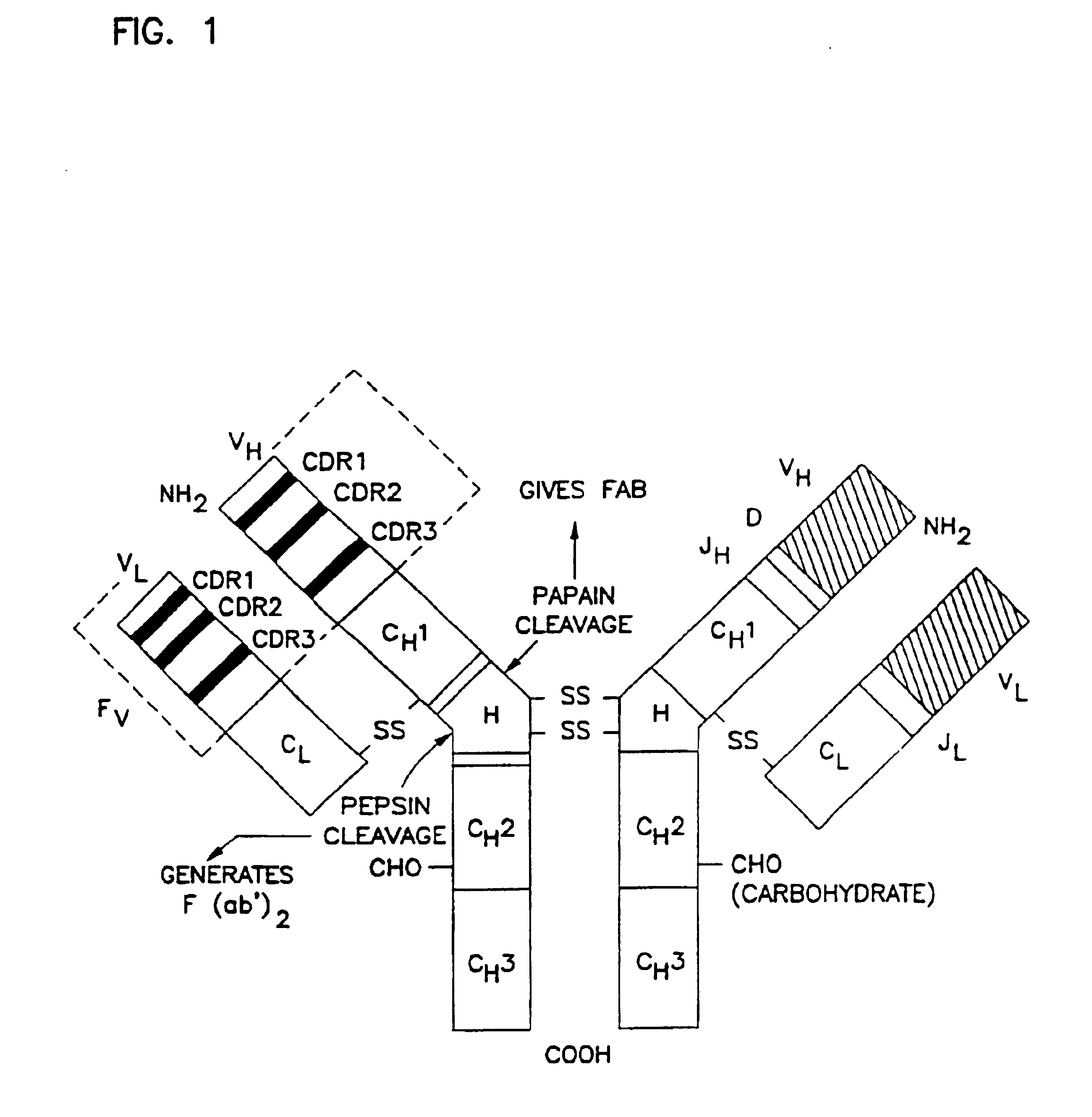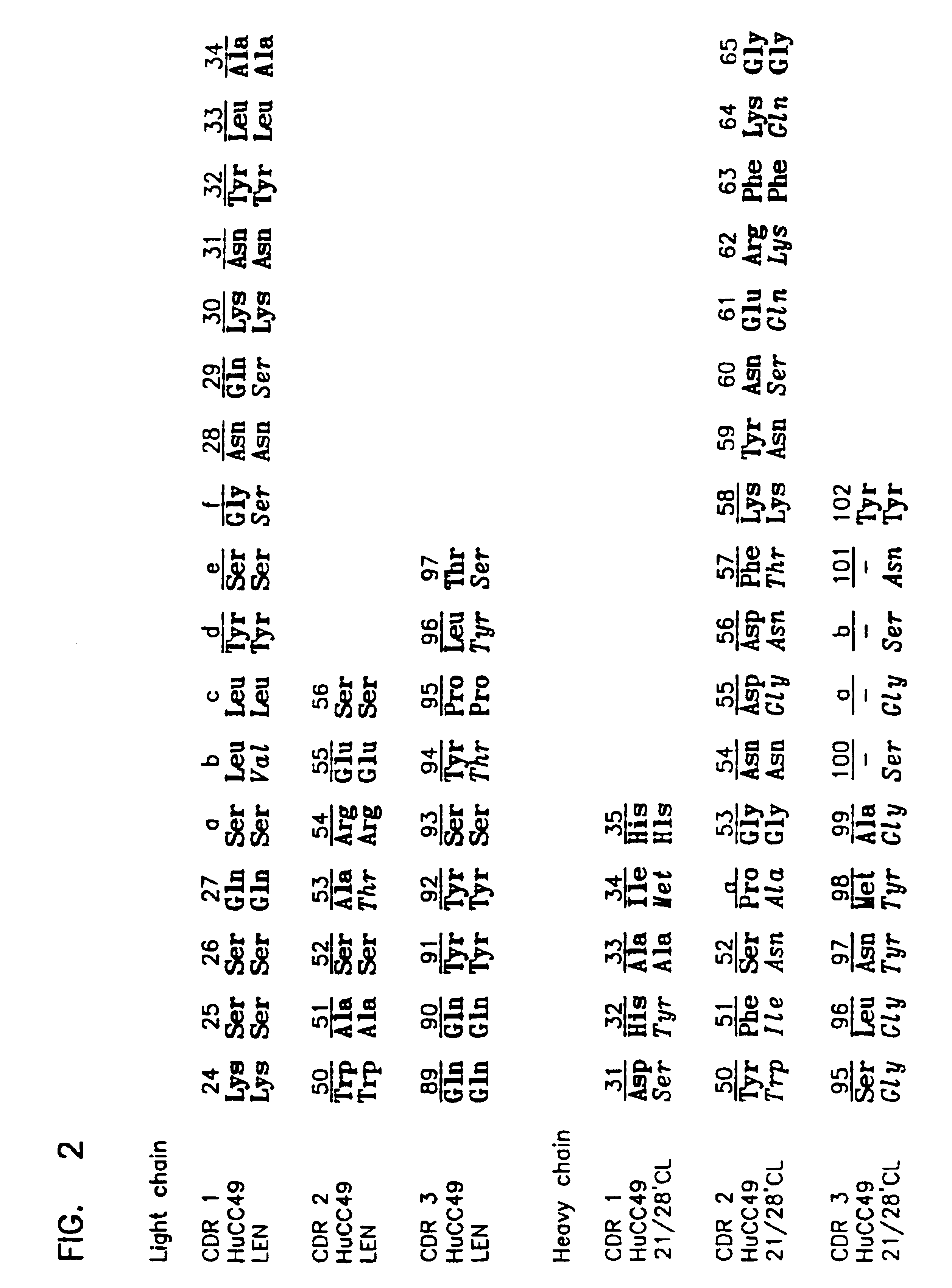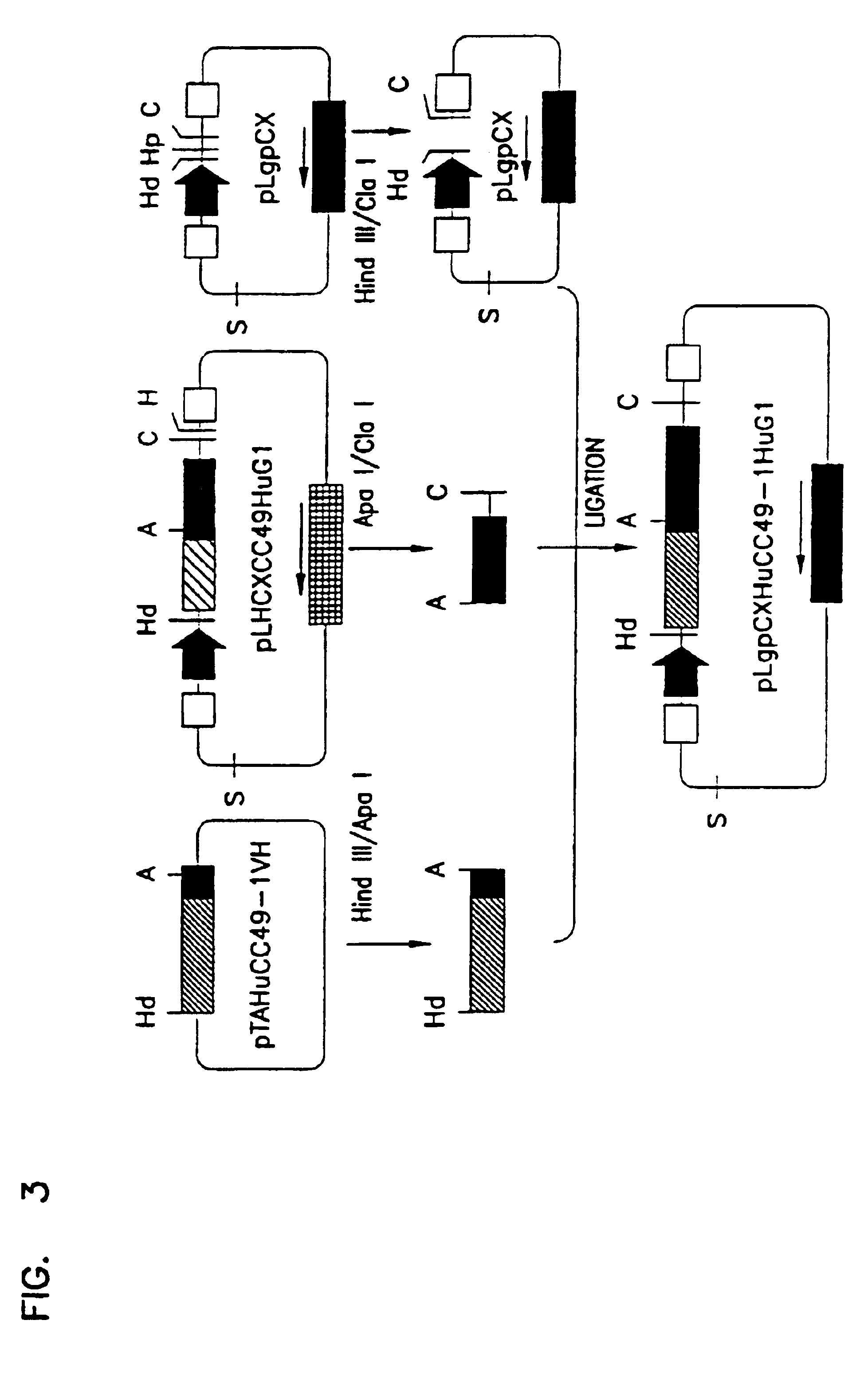Variants of humanized anti carcinoma monoclonal antibody cc49
a humanized anti carcinoma and monoclonal antibody technology, applied in the field of humanized anti carcinoma monoclonal antibody cc49, can solve the problems of harmful hypersensitivity reactions, repeated administration of hama, and severe restrictions in human use of monoclonal antibodies, and achieve the effect of eliciting minimal adverse reactions
- Summary
- Abstract
- Description
- Claims
- Application Information
AI Technical Summary
Benefits of technology
Problems solved by technology
Method used
Image
Examples
working examples
To identify the CDRs essential for binding, a panel of variant HuCC49 MAbs were generated using the baculovirus expression system. HuCC49 was prepared by grafting MAb CC49 CDRs onto the V.sub.L and V.sub.H frameworks of the human MAbs LEN and 21 / 28' CL, respectively, as described by Kashmiri et al., (1995) Hybridoma, 14:461-473. Six CDR variants were constructed by replacing a single CC49 CDR of either the light or heavy chain with the corresponding human antibody CMR (LEN and 21128'CL, respectively). Variants were denoted as L-1, L-2, L-3, H-1, H-2 or H-3. A seventh variant, L-1,2 was made by replacing two CC49 light chain CDRs (L-CDR1 and L-CDR2) with the corresponding CDRs of the human antibody LEN.
Since the seven CDR variants were derived by simply replacing the murine CDRs with the human antibody hypervariable regions, all of the variants carry identical V.sub.H and V.sub.L frameworks and .gamma.1 and k chain constant regions SDR heavy chain and light variants were constructed ...
example i
Preparation of CDR Substituted MAb CC49
According to the invention, CDR variants are formed by replacing at least one CDR of CC49 in HuCC49 with a corresponding CDR from a human antibody. The CDR variants of the invention include:
Variant L-1: L-CDR1 of CC49 (SEQ ID NO: 1) was replaced with L-CDR1 of LEN (SEQ ID NO: 7).
Variant L-2: L-CDR2 of CC49 (SEQ ID NO: 2) was replaced with L-CDR2 of LEN (SEQ ID NO: 8).
Variant L-3: L-CDR3 of CC49 (SEQ ID NO: 3) was replaced with L-CDR3 of LEN (SEQ ID NO: 9).
Variant L-1,2: L-CDR1 and L-CDR2 of CC49 (SEQ ID NOs: 1 and 2, respectively) were replaced with L-CDR1 and L-CDR2 of LEN (SEQ ID NOs: 7 and 8, respectively).
Variant H-1: H-CDR1 of CC49 (SEQ ID NO: 4) was replaced with H-CDR1 of 21128'CL (SEQ ID NO: 10).
Variant H-2: H-CDR2 of CC49 (SEQ ID NO: 5) was replaced with H-CDR2 of 21 / 28'CL (SEQ ID NO: 11).
Variant H-3: H-CDR3 of CC49 (SEQ ID NO: 6) was replaced with H-CDR3 of 21 / 28'CL (SEQ ID NO: 12).
Production of Oligomers to Generate V.sub.L Variants
S...
example ii
Assembly of CDR Substituted MAb CC49 PCR Products
The PCR products encoding the V.sub.H were treated with HindIII / ApaI. The PCR products were subcloned for sequencing in pBluescript S / K+ (Stratagene, La Jolla, Calif.) at a HindIII / ApaI site after the plasmid was linearized using the appropriate restriction endonucleases. Inserts were sequenced to check their fidelity to their templates.
To assemble the variable and constant regions of the heavy chain the HindIII / ApaI inset was released form pBluescipt A DNA fragment encoding the human .gamma.1 constant region was excited from pLgpCXHuCC49HuG1 (ashmiri et al, (1995) Hybridoma 14:461-473), (FIG. 3) by ApaI / ClaI cleavage. The HindIII / ApaI and the ApaI / ClaI fragments were joined. The recombinant was unidirectionally inserted, by three way ligation, between the HindIII and ClaI sites of pBluescript. The DNA sequence encoding the entire heavy chain was then cleaved from pBluescript by HindIII / ClaI digestion. Its termini were filled in using...
PUM
| Property | Measurement | Unit |
|---|---|---|
| radioactivity | aaaaa | aaaaa |
| volume | aaaaa | aaaaa |
| pH | aaaaa | aaaaa |
Abstract
Description
Claims
Application Information
 Login to View More
Login to View More - R&D
- Intellectual Property
- Life Sciences
- Materials
- Tech Scout
- Unparalleled Data Quality
- Higher Quality Content
- 60% Fewer Hallucinations
Browse by: Latest US Patents, China's latest patents, Technical Efficacy Thesaurus, Application Domain, Technology Topic, Popular Technical Reports.
© 2025 PatSnap. All rights reserved.Legal|Privacy policy|Modern Slavery Act Transparency Statement|Sitemap|About US| Contact US: help@patsnap.com



